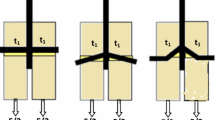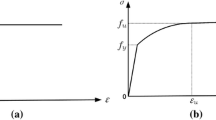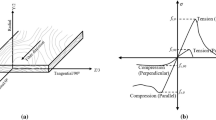Abstract
Failure of bolted timber joints is analyzed experimentally and numerically. In this study, the prediction of the load-carrying capacity of dowel-type joints with one dowel under static loading is based on the analysis of fracture in wood contrarily to most engineering methods that are based on the yield theory. Mechanical joints consist of glued laminated spruce members and steel dowels. In the different analyzed tests, the bolt loads the wood parallel or perpendicular to the grain. The wood member thickness is chosen sufficiently thin to avoid the fastener from presenting plastic hinges. The influences of different structural parameters such as the dowel diameter, the edge- and end-distances are investigated. The fracture propagation analysis is carried out with the Finite Element (FE) method in the framework of Linear Elastic Fracture Mechanics (LEFM). The only identified parameter is the critical energy release rate in mode I (GIc). The comparison between experimental and numerical results shows that the fracture must be considered for a correct prediction of the ultimate load and that LEFM can help to improve design codes.
Similar content being viewed by others
Author information
Authors and Affiliations
Additional information
Received 11 August 1997
Rights and permissions
About this article
Cite this article
Daudeville, L., Davenne, L. & Yasumura, M. Prediction of the load carrying capacity of bolted timber joints. Wood Science and Technology 33, 15–29 (1999). https://doi.org/10.1007/s002260050095
Issue Date:
DOI: https://doi.org/10.1007/s002260050095




